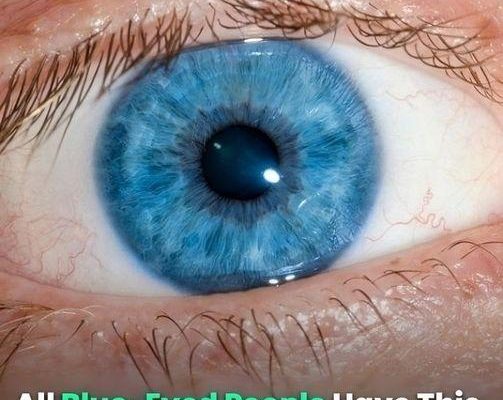Blue eyes are often considered striking and beautiful, but beyond their aesthetic appeal, all blue-eyed people share a unique genetic trait. Blue is the second most common eye color worldwide, but its origins trace back to a genetic mutation that occurred between 6,000 and 10,000 years ago. This mutation is responsible for the widespread presence of blue eyes today, and it continues to fascinate researchers.

Originally, all humans had brown eyes in varying shades, determined by the amount of melanin in the iris. However, a genetic mutation caused blue eyes to emerge. While this historical fact is interesting on its own, blue-eyed people also have several other notable characteristics that go beyond their eye color.
One of the most intriguing traits of blue-eyed individuals is their heightened sensitivity to light. According to Auckland Eye, a leading eye care provider, people with brown eyes have more melanin in their irises. This extra melanin provides better protection against harmful UV rays and blue light, which can damage the eyes. Blue-eyed people, on the other hand, have less melanin, making them more susceptible to light sensitivity, or photophobia. As a result, blue-eyed individuals are often more uncomfortable in bright sunlight or under harsh artificial lighting.
Despite the challenges of light sensitivity, blue eyes come with a few unexpected advantages. Joanna Rowe, a professor at Louisville University, conducted research suggesting that blue-eyed individuals may be better strategic thinkers. Highlighted by The Daily Mail, her findings indicate that people with blue eyes could excel in tasks that require focus, planning, and strategic thinking. Rowe admits that while this is an observation rather than a proven fact, it is still an interesting concept. Several famous intellectuals, including Stephen Hawking, Alexander Fleming, and Marie Curie, all had blue eyes, further supporting the idea that blue-eyed individuals might have enhanced cognitive abilities in certain areas.
Perhaps the most fascinating fact about blue-eyed individuals is their shared genetic history. Researchers have pinpointed a gene called HERC2, which is responsible for the development of blue eyes. This gene works in conjunction with another gene, OCA2, which influences melanin production. HERC2 essentially acts as a switch that turns off OCA2’s ability to produce brown eyes. Without the melanin that would normally create brown eyes, blue eyes are formed instead.
Professor Hans Eiberg, from the University of Copenhagen’s Department of Cellular and Molecular Medicine, has extensively studied this genetic mutation. He explains, “Originally, we all had brown eyes, but a genetic mutation affecting the OCA2 gene in our chromosomes led to the development of a switch that turned off the ability to produce brown eyes.” This mutation is believed to have occurred as humans migrated from Africa to Europe, which likely played a role in the prevalence of blue eyes among people of European descent today.
Further research from the University of Copenhagen suggests that all blue-eyed people alive today might share a common ancestor. This individual, who lived thousands of years ago, is thought to have been the first person to carry the genetic mutation responsible for blue eyes. While the identity of this person remains unknown, the evidence is compelling. Every blue-eyed individual carries the same genetic trait, indicating that they may all be descendants of this singular ancestor.
As Professor Eiberg points out, the discovery of this genetic mutation “shows that nature is constantly shuffling the human genome, creating a genetic cocktail of human chromosomes and trying out different changes as it does so.” Blue eyes are just one example of how these genetic variations can lead to fascinating and unexpected outcomes.
In summary, while blue eyes are often admired for their beauty, they also reveal a deeper story of human evolution and genetic diversity. From light sensitivity to potential cognitive advantages and shared ancestry, blue-eyed people truly have something unique in common.




